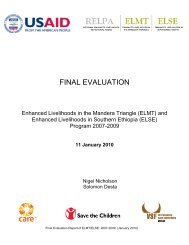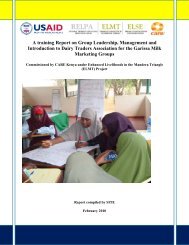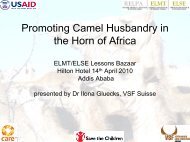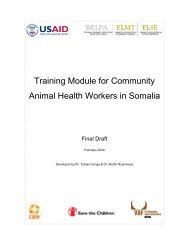care international in ethiopia – pastoral drop out study - ELMT Home
care international in ethiopia – pastoral drop out study - ELMT Home
care international in ethiopia – pastoral drop out study - ELMT Home
Create successful ePaper yourself
Turn your PDF publications into a flip-book with our unique Google optimized e-Paper software.
Cattle number<br />
100<br />
90<br />
80<br />
70 Figure 1: Cattle herd dynamics<br />
60<br />
50<br />
40<br />
30<br />
20<br />
10<br />
0<br />
1980/81 1982/83 1984/85 1986/87 1988/89 1990/91 1992/93 1994/95 1996/97<br />
Year<br />
Herd size<br />
Mortality<br />
Net sales<br />
Cattle population dynamics for 17 years (1980-97) exhibited a downward trend <strong>in</strong> cattle<br />
hold<strong>in</strong>gs per household as well as a “boom-and-bust” cycle (Fig. 1). On average, households<br />
reportedly lost 67 head of cattle to drought-related mortality over 17 years, largely due to<br />
starvation (Desta, 1999). Death losses were 10 to 15 times greater than net sales, <strong>in</strong>dicat<strong>in</strong>g<br />
that natural factors—not market<strong>in</strong>g—regulated the population size. Borana are becom<strong>in</strong>g<br />
poorer and poorer over time as cattle hold<strong>in</strong>g per capita dw<strong>in</strong>dle. Increas<strong>in</strong>g number of<br />
Borana are hav<strong>in</strong>g smaller number of cattle herd as more and more Borana fall on the<br />
downside of the household herd size distribution (Fig 2). Larger proportions of he<br />
households were on the upside of the distribution <strong>in</strong> 1980-84 than <strong>in</strong> 1986-90, which was<br />
better compared to 1992-97.<br />
With<strong>out</strong> adequate social safety nets or <strong>in</strong>formal means of <strong>in</strong>surance, people whose animals<br />
die and who lose their sources of livelihood are forced to <strong>drop</strong> <strong>out</strong> of the <strong>pastoral</strong> system.<br />
This often has detrimental consequences for those who <strong>drop</strong> <strong>out</strong> s<strong>in</strong>ce they are usually ill<br />
equipped to succeed <strong>in</strong> more urban sett<strong>in</strong>gs. In addition, there can be detrimental effects to<br />
smaller towns and villages <strong>in</strong> <strong>pastoral</strong> areas. They cannot absorb an <strong>in</strong>flux of unskilled labor,<br />
and their immediate environment can suffer as <strong>pastoral</strong> <strong>drop</strong>-<strong>out</strong>s br<strong>in</strong>g their few animals<br />
and concentrate around towns, lead<strong>in</strong>g to localized range degradation. Address<strong>in</strong>g poverty <strong>in</strong><br />
<strong>pastoral</strong> areas fundamentally revolves around two key elements. First, <strong>pastoral</strong> production<br />
should be improved and supported, not replaced, for the majority of <strong>pastoral</strong>ists with the<br />
skills and <strong>in</strong>terests to cont<strong>in</strong>ue traditional livelihoods. It has proven to be effective and there<br />
6












